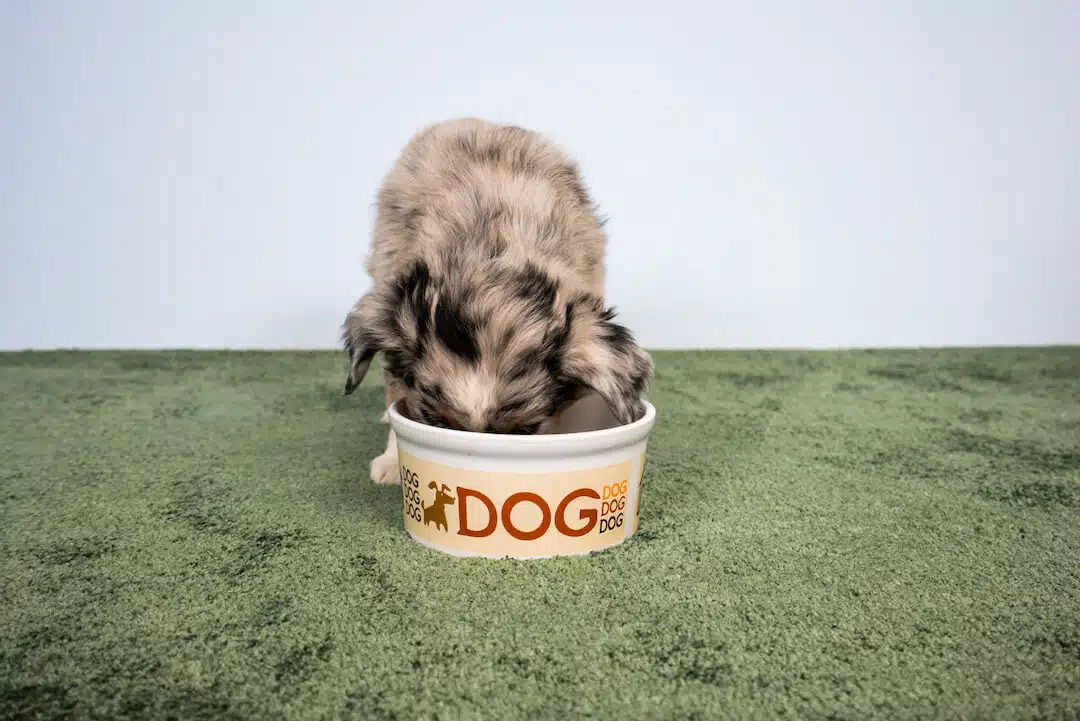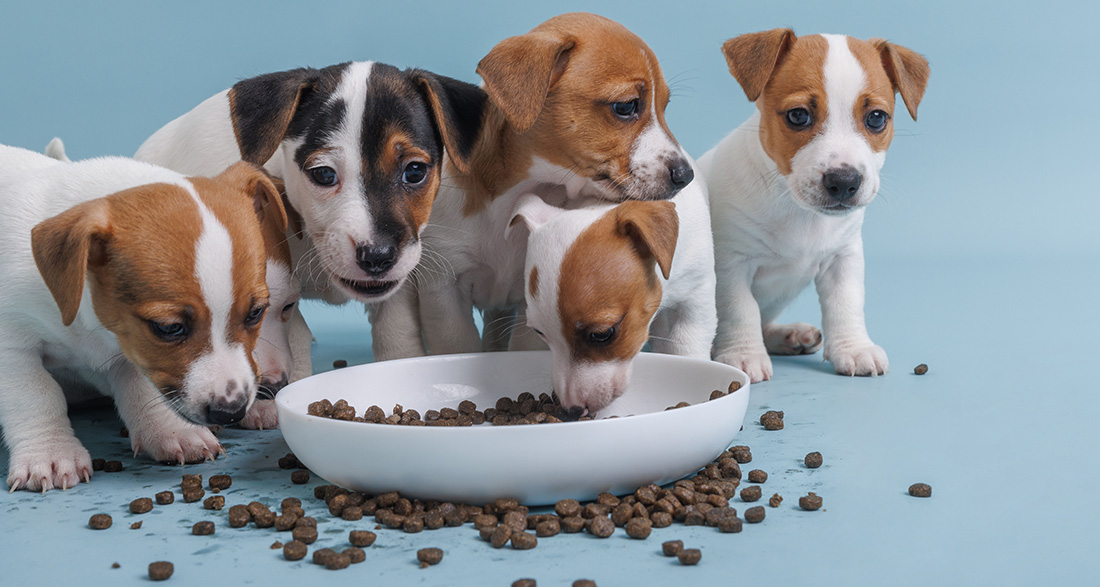Looking for the best food for your puppy? Our puppy food test shows you the best puppy foods on the market. In addition to our test winners, you’ll find many more recommendations and helpful information on healthy and species-appropriate puppy nutrition on this page.
Our Top Picks
[table id=11 cache_table_output=false /]
Who is this test for?
This report is aimed at anyone who has a young puppy and wonders, “What is the best dog food for my puppy?” Especially in the early stages of a puppy’s life, it’s crucial to determine the right food to ensure they grow big and strong. But don’t worry, we’ll walk you through everything you need to know step by step on this topic.
How we test 🐶
For this guide, I consulted a veterinarian regarding all the important questions about puppy nutrition. I asked the breeder I trust for advice, as I recently had a small pug puppy at home. To confirm, I also looked at other reliable reports from various sources.
Are you looking for the right puppy food for your junior? Then use our test reports for an individual puppy food comparison. Choose your desired brand from our many testimonials, open the test report, and compare your favorite brands with each other.
Recognizing Good Puppy Food
Many claim that puppyhood is the most beautiful time in life with your four-legged friend. To properly feed the playful and curious puppy in the first months, choosing high-quality puppy food is crucial.
Not only does the rapid growth phase of the puppy occur in the first six months of life, but the foundation for a healthy dog life is also laid during puppyhood.
Balanced and healthy nutrition is one of the most important things in puppyhood. Improperly fed puppies are often more susceptible to health problems in old age, such as joint and bone issues.
Especially with large breeds, one quickly wonders what the small puppy can already eat at that age. Due to the rapid growth phase, a puppy needs almost twice as much energy as an adult dog.
Quality Features of Puppy Food

Especially in puppyhood, where the foundation for a healthy dog life is laid, the following quality features should be considered when choosing food:
Open and Transparent Declaration (Listing of all ingredients)
An open and transparent declaration is a basic requirement for assessing the quality of puppy food. Therefore, make sure that all ingredients are listed individually and with percentages.
Free from Chemicals (Preservatives, Colorants, Flavors, and Attractants)
In addition, the manufacturer should refrain from using chemicals. These are primarily binders, artificial preservatives, flavors, attractants, and colorants. These substances can harm the puppy’s intestinal flora and have no nutritional significance.
No Flavor Enhancers (Fats, (Hidden) Sugars)
Flavor enhancers should also not be included in the composition or in the list of any additives. These include undefined fats, as well as sugar-containing ingredients or sweeteners.
Meat Content & Selection of Animal By-Products (Offal)
Both the meat content and the quality and selection of animal components should play a major role in choosing puppy food. The puppy’s digestive system is naturally adapted to a diet that is high in meat. Due to the short length of the intestines, vegetable proteins can hardly be utilized. Therefore, nutrition with high-quality animal proteins is all the more important. These are found, among other things, in muscle meat. A high muscle meat content is therefore an indication of quality.
The selection of animal by-products should be clearly visible based on a transparent composition. High-quality animal by-products (offal) include, among other things, liver, lungs, and heart. If the animal by-products are not listed individually, there is usually a reason for this. Poor-quality animal by-products can end up in the feed, such as slaughterhouse waste, horns, hides, and skins.
Free from Gluten-Containing Grains (Wheat, Barley, Corn)
For puppies, we recommend starting with the feeding of carbohydrates at the earliest at the age of 12 weeks. It takes a while for all enzymes needed for the digestion and utilization of carbohydrates to be produced in sufficient numbers. However, we generally recommend feeding a gluten-free puppy food.
Origin and Quality of Ingredients (Manufacturer’s Philosophy)
Last but not least, the origin and quality of the ingredients should also play a role in choosing food. In our test reports, we always take a closer look beyond the label and gather more information about the manufacturer and the production conditions. A dog food from Sweden benefits just as much as a dog food with ingredients in organic quality.
Your checklist for Puppy Food
Here’s what to look for when choosing food:
- Does the food have a high meat content?
- Does the food contain healthy carbohydrates like rice, potato?
- Does the food contain minerals (such as sodium, calcium, phosphorus)?
- Does the food contain vegetables and animal by-products (offal)?
- Does the food contain high-quality proteins and fats?
- Are trace elements (such as copper, zinc, manganese) in the food?
Ingredients in Puppy Food

Small paws, small teeth, little muscle, and lots of energy – in a young dog, the entire organism needs to develop, similar to a young human. To ensure that the growth process does not lead to disturbances or deficiencies, puppy food should contain sufficient vitamins, trace elements, and minerals. Especially important for the first months of the animal are the following ingredients in the food.
- High meat content in the food
- Animal by-products (offal)
- Healthy carbohydrates (such as rice, potato)
- Fruits and vegetables
- High-quality proteins and fats
- Minerals (such as sodium, calcium, phosphorus)
- Trace elements (such as copper, zinc, manganese)
- Vitamins
Dogs are naturally carnivores and therefore require a high meat content in their diet. Barfers are also aware that the diet should not only consist of muscle meat. Animal by-products are also an important part of species-appropriate and healthy puppy nutrition. High-quality animal by-products include rumen, lung, gizzards, kidneys, heart, carcasses, throats, poultry stomachs, and liver.
These by-products contain important vitamins and nutrients that are essential for proper nutrition. But beware, the term animal by-products encompasses much more than the organs listed. According to Law of the United States, other parts such as hooves, udders, horns, skins, ovaries, testicles, intestines, and hides can also end up in the feed. If these by-products are used, it is often not clear from the declaration alone. Therefore, inform yourself about the ingredients of the feed before making a choice and pay attention to the labeling.
Wet food or dry food for puppies?
Most new puppy owners are initially faced with the decision of whether wet food or dry food is the better choice for the junior/puppy.
First, let’s take a look at the advantages and disadvantages of wet feeding for puppies:
Pros of Wet Food
- high moisture content
- high acceptance
- resembles a natural way of eating
- often gentle production, e.g., by cold filling
- premium brands with food-grade ingredients
- high meat content possible
Cons of Wet Food
- larger amounts of waste with cans
- impractical for travel and vacations with the dog
- short shelf life of opened cans
We are clearly in favor of wet feeding for good reasons. A high meat content and healthy ingredients enable species-appropriate puppy nutrition. The advantages are clear and apply both during the puppy phase and beyond.
And the disadvantages of wet feeding are more likely to affect the two-legged family than the puppy itself. But beware: not every wet food is high-quality and healthy just because it’s wet. Our wet food test shows you our personal recommendations.
But what are the advantages and disadvantages of feeding dry food? A brief overview:
Pros of Dry Food
- often cheaper than wet food
- easy to use, even during vacations
- simple portioning of the food
- longer shelf life when opened
Cons of Dry Food
- loss of nutrients and vitamins during manufacturing, which need to be artificially replaced, e.g., in extruded dog food
- low moisture content in the food can rarely be compensated by drinking (possible kidney damage as a result)
- frequent damage to the intestinal flora due to chemicals (e.g., preservatives)
- rarely high meat content, and fresh meat cannot be directly processed
- common trigger of allergies or food intolerances (e.g., due to gluten)
- does not correspond to the natural diet of the dog
- declarations are rarely transparent and often misleading (e.g., when stating fresh meat)
The advantages of feeding dry food lie with us humans, while the disadvantages are faced by the dog. Even though there are now high-quality dry foods on the market that are free of grains and (supposedly) any chemicals, dry feeding does not correspond to the nature of the dog.
Unfortunately, the myth that dry food is good for dental health still persists to this day. Ultimately, we would never feed our dogs dry food as their main diet under any circumstances.
Frequently Asked Questions (FAQ)
After mother’s milk, after the breeder, and after growth: a puppy usually changes its food around three times in its first year of life. We have selected and answered the most common questions about puppy nutrition and food transitions.
What is the best puppy food?
Determining the best puppy food is not possible because every puppy has different needs. Factors such as breed, activity level, and health also play a significant role in choosing the right puppy food. However, our 2024 puppy food test can help you select the right puppy food.
Which wet food is best for puppies?
A dog should be fed an appropriate and healthy diet, regardless of the life stage. A high-quality wet food can be a good option here. On our website, we have tested some wet puppy foods and present our recommendations.
Which Dry Food for Puppies?
Many puppies have already been fed dry food by the breeder. Some of the new dog owners want to continue this at home. We’ll show you our recommendations from our puppy dry food tests.
How often should I feed the puppy daily?
A puppy should be fed three to four times a day. This is especially true for the first few weeks of life.
How can I recognize a good puppy food?
Recognizing a good puppy food is easier than many think. Good puppy foods can be identified by, among other things, transparent labeling and a healthy, species-appropriate composition. The meat content and the choice of ingredients play a crucial role here.
Which dog food for puppies?
We personally recommend feeding a species-appropriate wet food. In our test reports, we have tried many puppy foods in wet and dry varieties for you.
Wet food or dry food for puppies?
There are pros and cons on both sides. We personally recommend wet feeding. Why? We’ll show you in this puppy food test.
Should puppy food be grain-free?
Grains or the contained gluten – as in wheat or barley – are often suspected to be the cause of intolerances or allergies. In addition, grains contain many carbohydrates. However, puppies only have fully developed enzymes for digestion from about the twelfth week onwards.
The entire digestion of a dog is designed for animal food. Thus, proteins of animal origin can be much better utilized than is the case with plant proteins. One reason for this is the comparatively short intestine of the dog.
How much food do puppies need?
Manufacturers usually provide a feeding recommendation for their products. The calculation is based either on the current weight or the expected final weight of the puppy.
What are the advantages of wet food for puppies?
The advantages of high-quality wet food for puppies include high moisture content, high meat content, a healthy composition, the absence of chemicals, and high palatability. We have tested some wet puppy foods and present them in our puppy food test.
What are the disadvantages of dry food for puppies?
One of the disadvantages of feeding dry food to puppies is the low moisture content in dry food. Many types of dry food also contain little meat, but a lot of grains. The latter is not only considered fattening but also a common trigger for allergies or intolerances.
When can puppies be weaned?
The transition from mother’s milk to solid food begins after four to five weeks. Puppies are still very small at this time, and their stomachs would be quickly overwhelmed by larger portions. Therefore, it is recommended to distribute daily food into at least three to four meals. Gradually, you can then wean the puppies off of mother’s milk.
When can you change the food from the breeder?
Regardless of the food the puppy previously received from the breeder, always ask about the brand. It is important that the puppy continues to receive the familiar food in the first few days. The move and the new family already provide enough stress, so a change of food is recommended only after at least a week.
How does the food transition work for puppies?
A food transition for puppies should never be abrupt. Ideally, ask your breeder for some food for the first few days. The transition should not take place directly on the first day in the new home. Give your puppy some time to get used to the new environment first. Because a simultaneous food transition is far too stressful for the little ones.
How long does a food transition take for puppies?
The duration of a food transition for puppies varies from puppy to puppy. Generally, it is advisable to take at least a week for a gentle food transition.
What to do in case of diarrhea in puppies?
Diarrhea is one of the most common side effects of a food transition. However, diarrhea can quickly become dangerous for puppies. Therefore, in case of emergency, you should rather stop the food transition and switch to feeding a bland diet to prevent your puppy from becoming dehydrated and to ensure they receive enough fluids and nutrients. Once the digestion has calmed down, you can continue with the food transition.
How long should puppy food be fed?
While some dog foods are suitable for dogs of all life stages, special puppy foods usually have an age limit. Typically, this ranges from six to twelve months. When making a purchase, pay attention to the manufacturer’s instructions.


